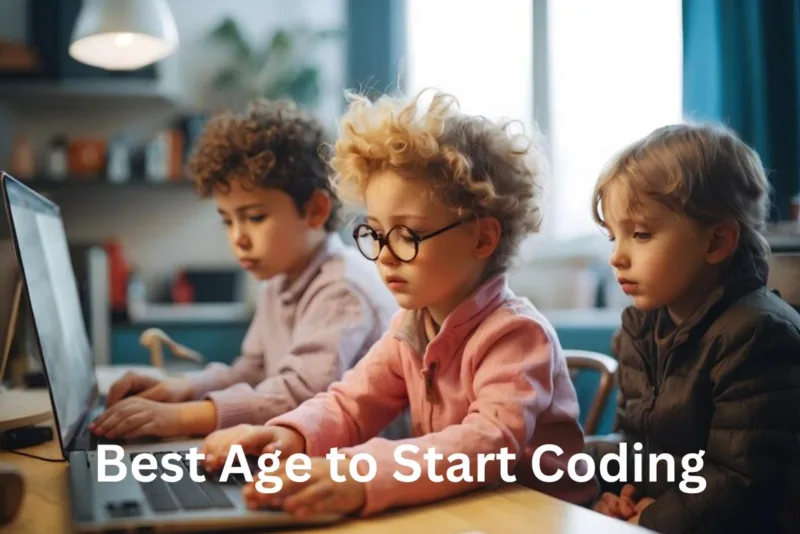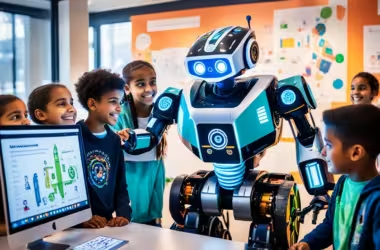If you’re in search of the Best Coding Courses For Kids, then you’re at the right place because this guide has all your answers.
As a matter of fact, studies reveal that 90% of parents want their kids to learn coding, but only 40% of schools actually teach it? That’s a big gap!
The good news is, you can help your child bridge that gap with some fun and engaging websites. These websites make coding feel less like work and more like playing awesome games!
After going through our well-curated list, you’ll have a treasure chest full of ideas to get your kids hooked on coding.
Let’s look at the list;
Best Coding Courses For Kids
Now, let’s go through the Best Coding Courses For Kids in 2024 you can choose from;
1. Code.org
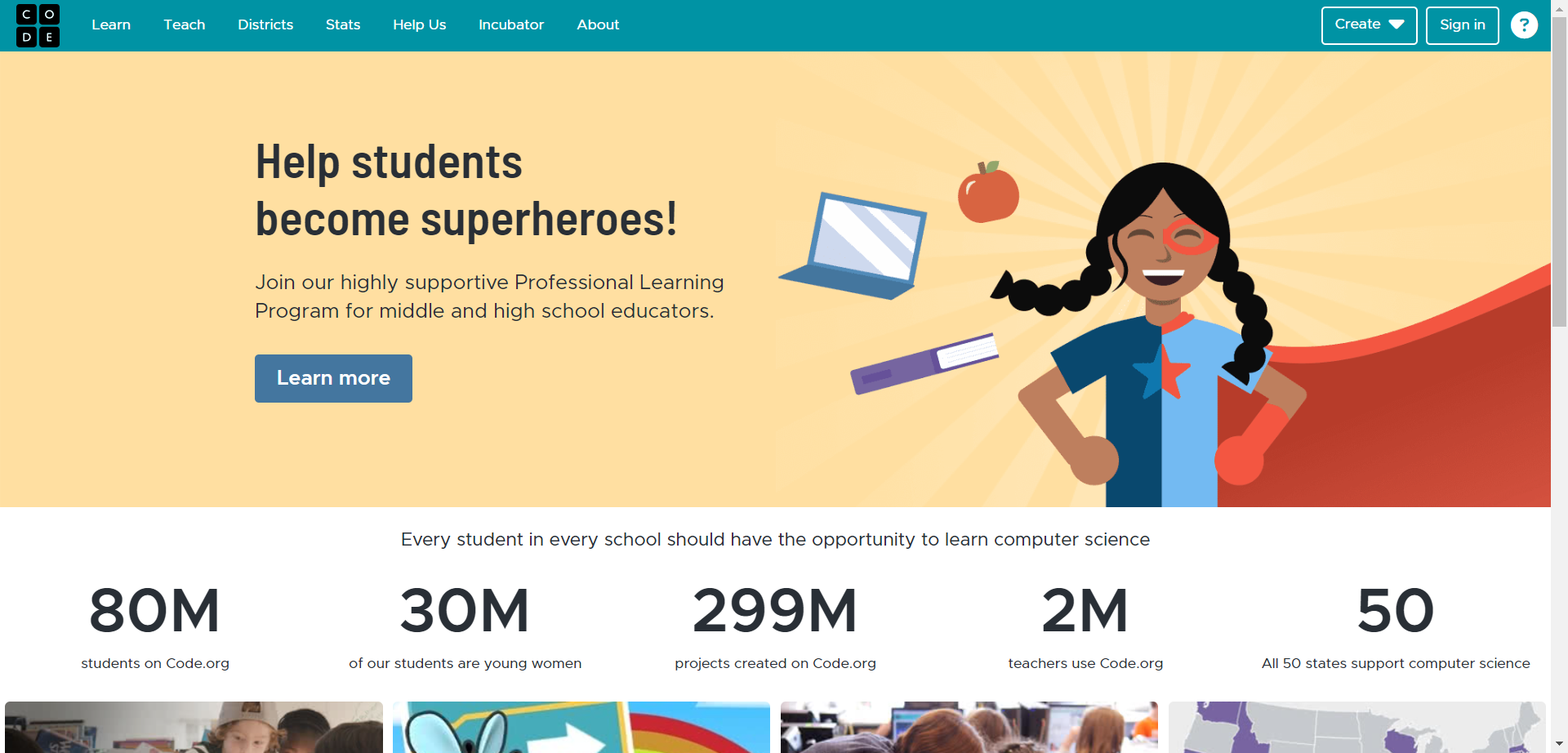
Code.org stands out as a non-profit organization dedicated to expanding access to computer science education for everyone.
Their website offers a vast collection of free coding courses, tutorials, and resources designed to engage learners of all ages, from absolute beginners to seasoned coders.
Whether you’re a curious kindergartener or an adult looking to brush up on your coding skills, Code.org can help out.
Features:
- Free online coding courses for various age groups and skill levels
- Interactive tutorials and challenges that make learning to code fun and engaging
- Uses a variety of popular programming languages like Javascript, Python, and Scratch
- Offers resources for educators including lesson plans, professional development, and curriculum alignment
- Strong focus on diversity and inclusion in computer science education
Best Suited For: All ages (beginners to advanced learners)
Price: Free
Pros:
- Completely free and accessible resource for learning coding concepts
- Offers a wide range of courses catering to different interests and skill levels
- Uses engaging and interactive activities to make learning fun and motivating
- Provides valuable resources for educators to integrate coding into their curriculum
- Promotes diversity and inclusion in the field of computer science
Cons:
- Might not offer the same in-depth learning experience as some paid courses
- The sheer amount of resources might be overwhelming for some users
- Requires self-motivation and time management skills for independent learning
2. Scratch
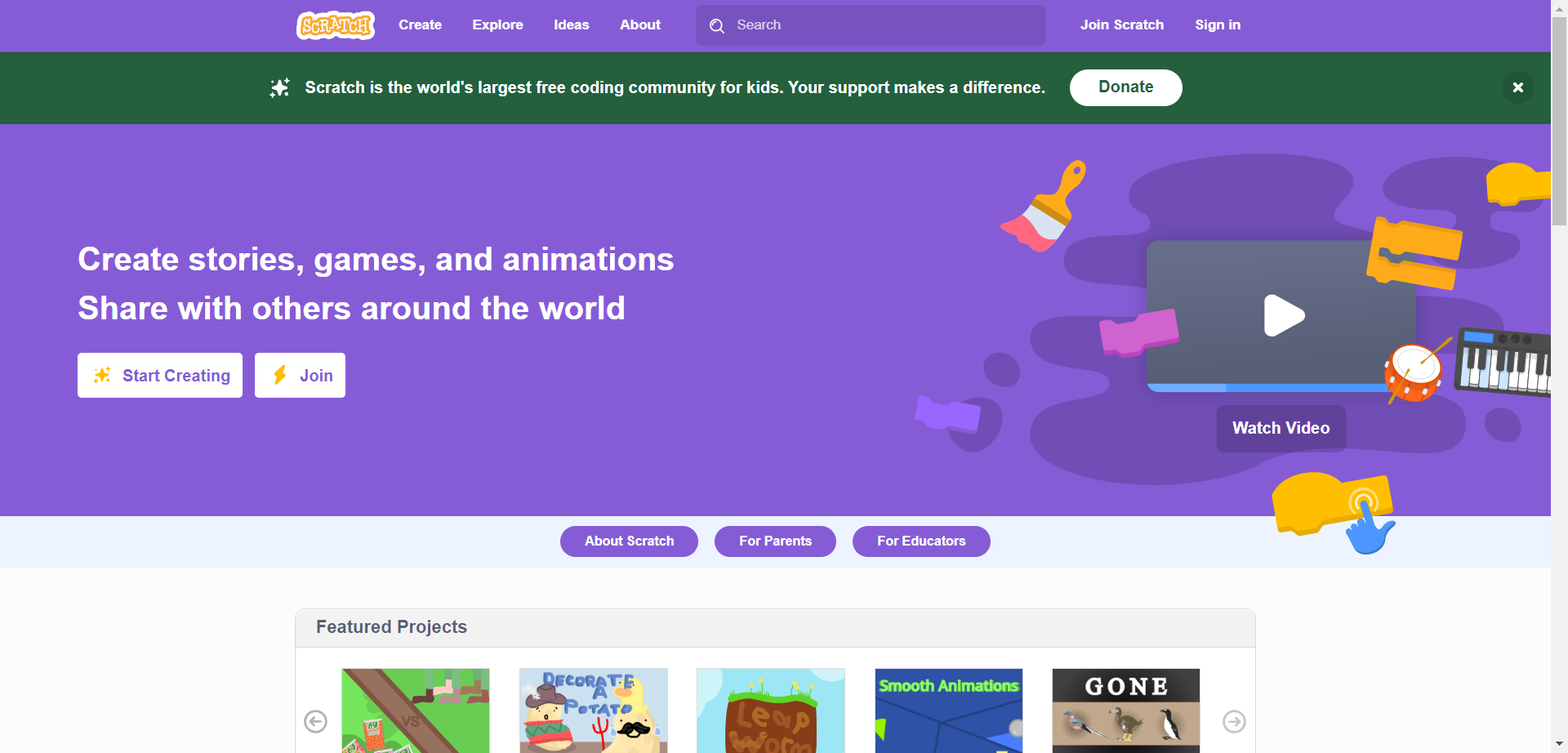
Scratch is a free coding platform developed by MIT. It uses a visual drag-and-drop interface where kids can create animations, games, and stories using colorful code blocks. Scratch offers a vibrant online community where kids can share their creations and get inspired by others.
Features:
- Free to use
- Drag-and-drop block coding
- Large library of characters, sounds, and backgrounds
- Tutorials, projects, and online community
Best Suited For: Ages 8-12 (beginners)
Price: Free
Pros:
- Completely free and accessible
- Intuitive interface makes it easy for beginners to learn
- Encourages creativity and storytelling through coding
Cons:
- Limited complexity compared to text-based coding
- Can be visually overwhelming for younger children
3. Tynker
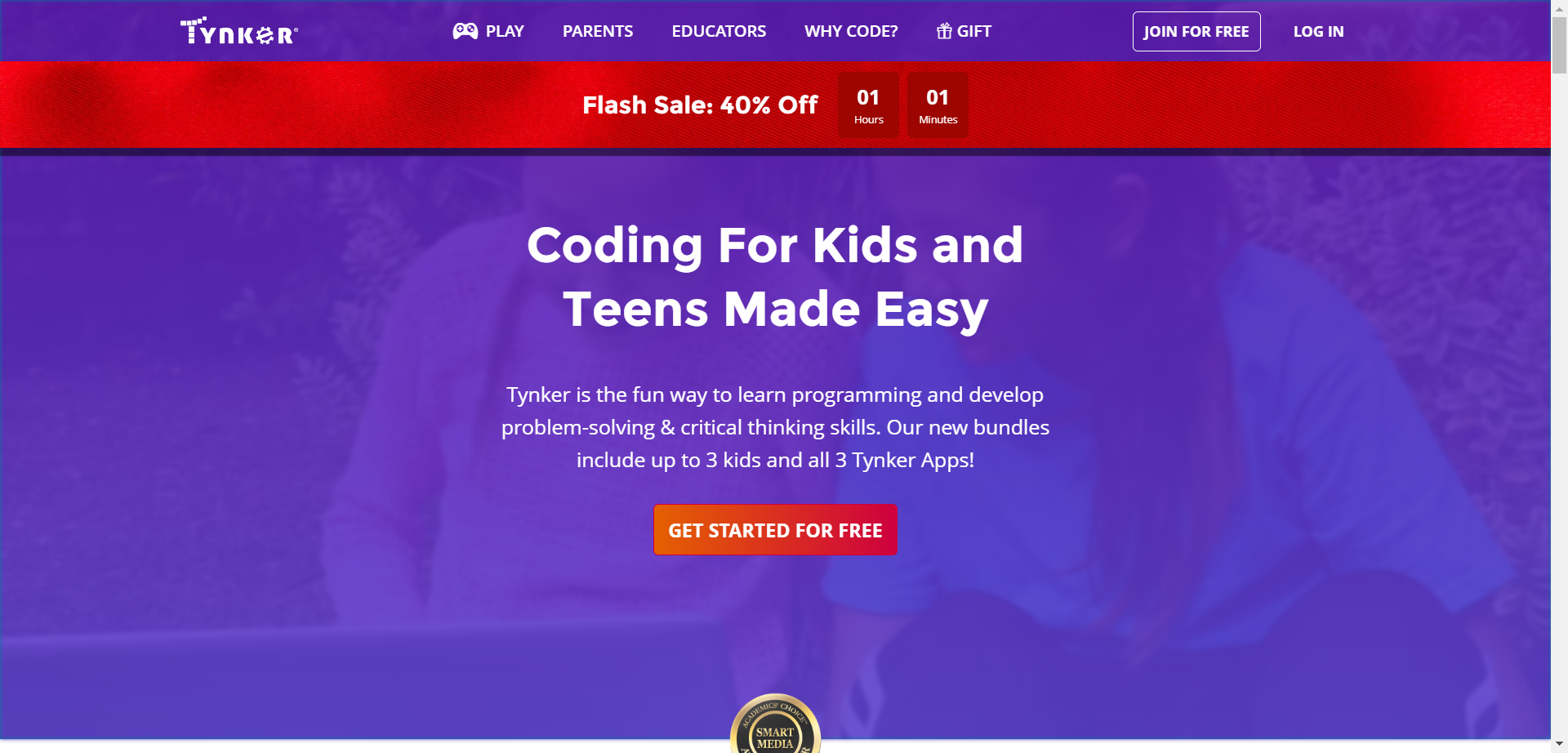
Tynker is another excellent platform for beginner coders, offering a fun and interactive way to learn core coding concepts. Like Scratch, it makes use of a visual block-coding interface, but Tynker presents coding challenges in a more gamified way, with storylines and characters that keep kids engaged.
Features:
- Free and premium subscription plans available
- Drag-and-drop block coding with various difficulty levels
- Interactive coding challenges with storylines and characters
- Award system and progress tracking
Best Suited For: Ages 5-12 (beginners)
Price: Free plan with limited features. Premium plans offer access to more characters, challenges, and courses.
Pros:
- Engaging gamified learning approach keeps kids motivated
- Offers a free plan to try before you buy
- Wide range of challenges catering to different interests (e.g., game design, animation)
Cons:
- Free plan has limitations, and premium plans can be expensive
- Interface might be slightly less intuitive compared to Scratch
4. Khan Academy
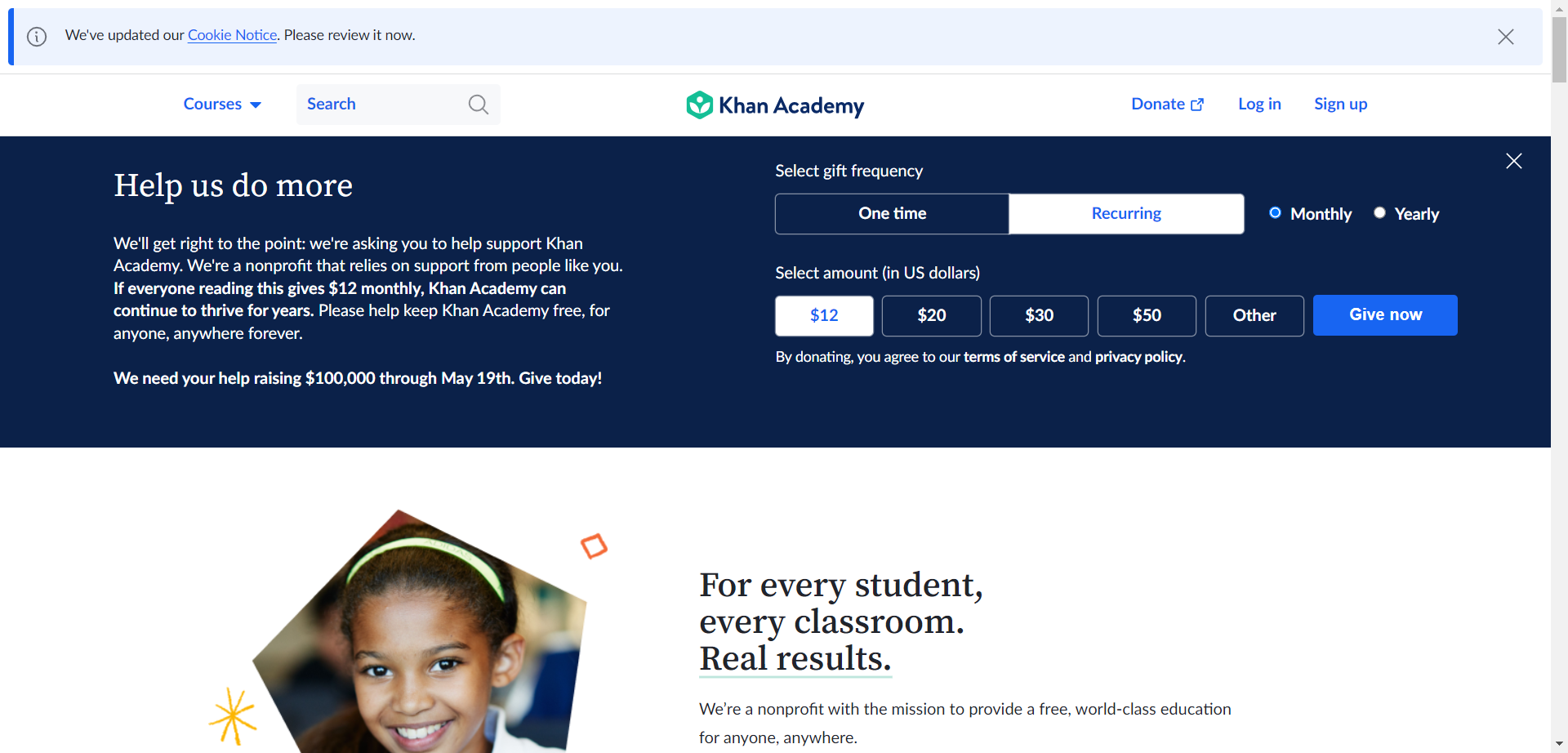
Khan Academy, a household name in online education, also offers a fantastic free resource for introducing kids to coding. Their “Khan Academy Kids Programming” section features interactive courses and challenges designed specifically for young learners.
While it doesn’t use block-based coding like Scratch or Tynker, Khan Academy focuses on teaching fundamental coding concepts through puzzles, games, and creative activities.
Features
- Completely free to use
- Interactive puzzles, games, and activities focused on coding logic
- Teaches core concepts like sequencing, loops, and conditionals
- Integrates well with other Khan Academy Kids learning materials
Best Suited For: Ages 4-8 (absolute beginners)
Price: Free
Pros:
- Completely free and accessible resource from a trusted educational platform
- Focuses on building a strong foundation in coding logic before diving into specific languages
- Offers a variety of engaging activities to cater to different learning styles
- Integrates well with other Khan Academy Kids learning materials for a holistic educational experience
Cons:
Doesn’t use visual block-based coding like other options
Might be too basic for older children who are already familiar with coding concepts
5. CodeCombat
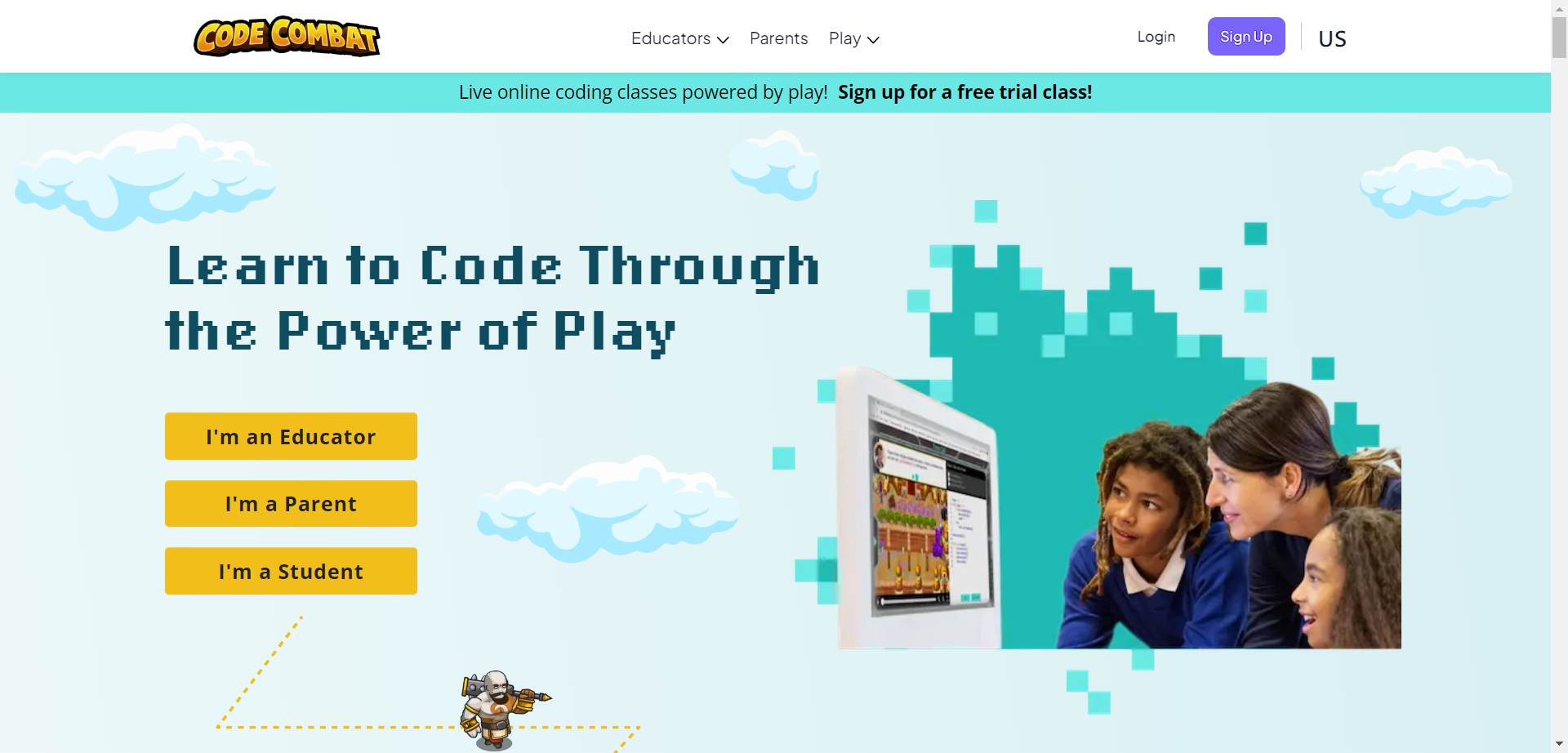
CodeCombat takes coding challenges to a whole new level by transforming them into role-playing games!
Kids can learn valuable coding concepts like loops, functions, and variables by battling monsters, solving puzzles, and leveling up their characters in a captivating fantasy world.
Features:
- Free and premium subscription plans available
- Role-playing game (RPG) style learning environment
- Teaches coding concepts through in-game challenges and adventures
- Various difficulty levels and programming languages (Python, JavaScript)
Best Suited For: Ages 8-16 (beginners with some experience)
Price: Free plan with access to basic content. Premium plans offer additional features and game worlds.
Pros:
- Engaging RPG format keeps kids motivated and learning
- Introduces more advanced coding concepts in a fun and interactive way
- Offers a free plan to explore the platform before committing
- Teaches both basic and more complex coding languages
Cons:
- Free plan has limitations on content and available languages
- Might be overwhelming for absolute beginners with no prior coding experience
6. Blockly
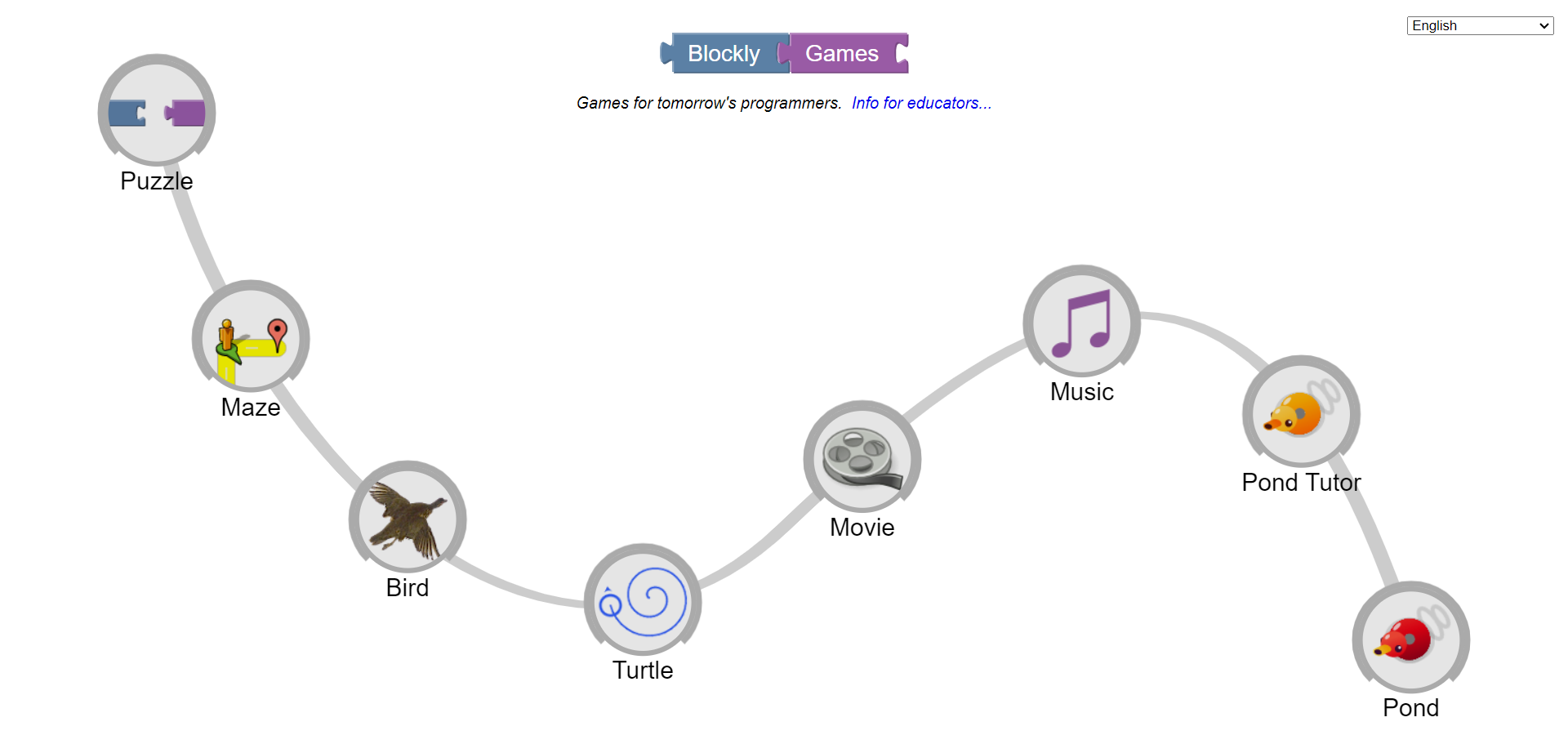
Blockly might not be a standalone course, but it’s a powerful and versatile coding platform that deserves a mention.
Developed by Google, Blockly serves as the foundation for many coding programs for kids, including Scratch and CodeMonkey.
It offers a visual block-based coding interface that can be customized to teach a wide range of programming languages.
Features:
- Open-source and often integrated into other coding platforms
- Customizable interface to teach various programming languages
- Drag-and-drop block coding with clear visual representation
- Can be used to create simple games, animations, and interactive programs
Best Suited For: Ages 5 and up (beginners with some guidance)
Price: Free (often integrated into other coding programs)
Pros:
- Highly versatile and adaptable to different coding languages
- Intuitive block-based coding makes it easy for beginners to grasp concepts
- Free to use and often integrated into other coding platforms you might already be using
- Encourages experimentation and exploration in a safe coding environment
Cons:
- Not a standalone course and requires some guidance from parents or teachers
- The learning experience might vary depending on the platform it’s integrated with
- Limited complexity compared to text-based coding
7. CodeMonkey
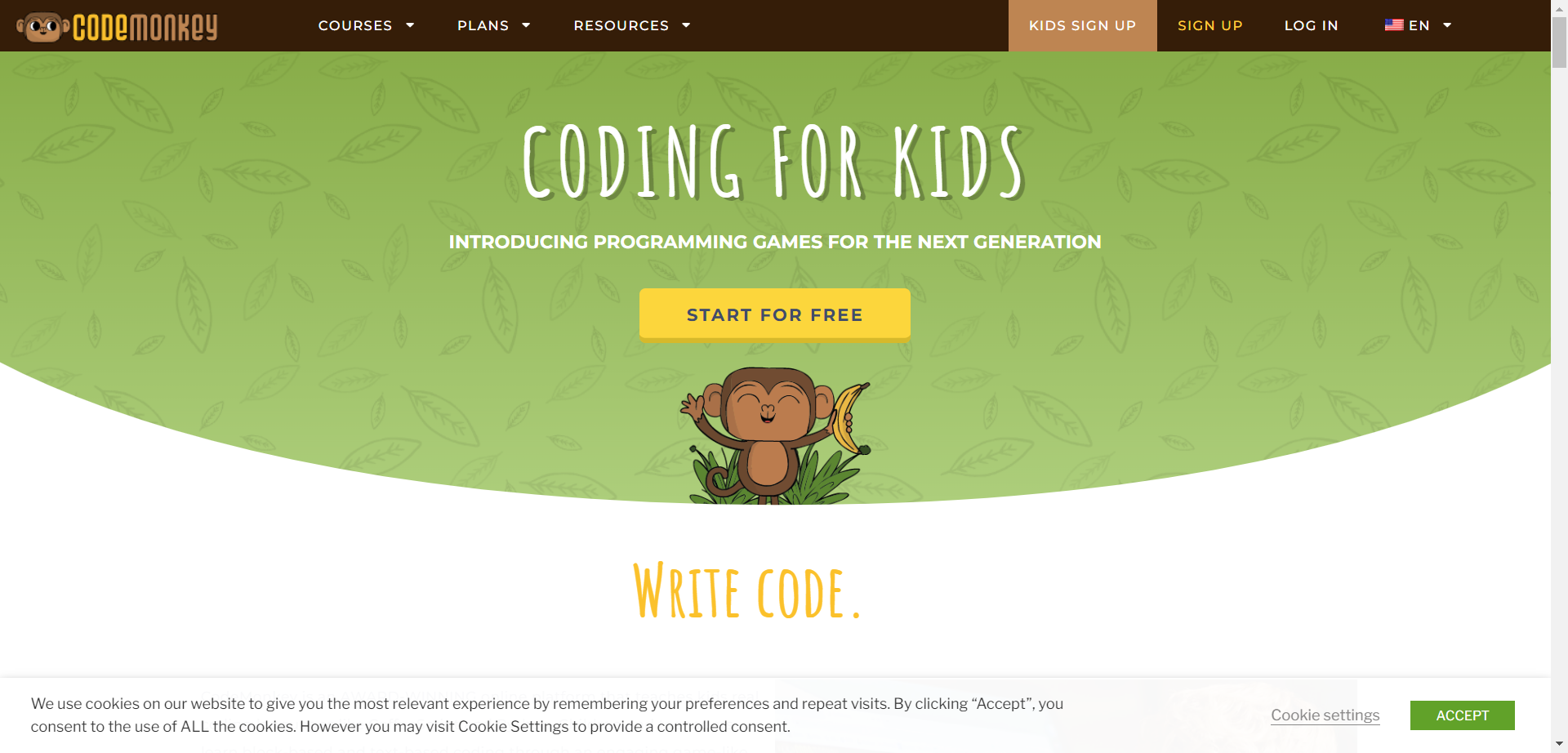
CodeMonkey takes a unique approach to teaching coding, using a combination of fun animations and interactive challenges to introduce basic programming concepts.
Unlike Scratch and Tynker’s block-based coding, CodeMonkey uses a more visual coding style where kids control characters by writing simple commands. This approach offers a smoother transition to text-based coding later on.
Features
- Free and premium subscription plans available
- Interactive coding challenges with storylines and adorable monkey characters
- Focuses on writing simple commands rather than drag-and-drop blocks
- Integrates math concepts like sequencing and loops
Best Suited For: Ages 5-10 (beginners)
Price: Free plan with limited access to challenges. Premium plans offer more content and features.
Pros:
- Engaging animations and storylines keep kids entertained while learning
- Introduces basic coding concepts like sequencing and loops in a fun way
- Offers a free plan to try before you buy
- Lays a foundation for transitioning to text-based coding later
Cons
- Free plan has limited content and may not be as engaging for older kids
- The coding style might be slightly different from traditional block-based coding
8. Create & Learn
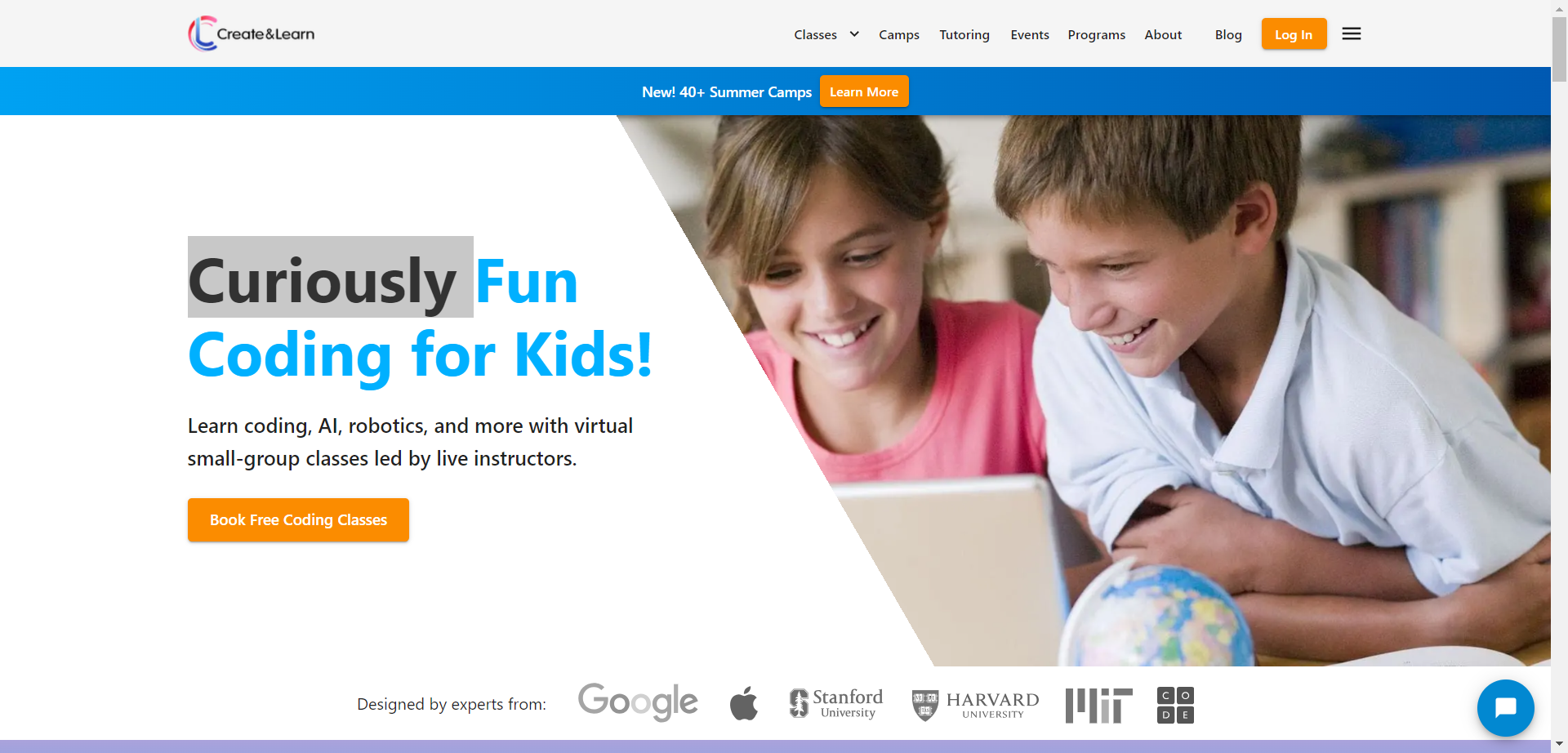
Create & Learn offers a variety of online coding classes designed to make learning to code fun and accessible for kids of all ages.
Their curriculum utilizes a project-based approach, where kids learn coding concepts by creating real-world projects like animations, games, and even websites.
This approach keeps students engaged and motivated while solidifying their understanding of coding principles.
Features:
- Variety of online coding classes for different age groups and skill levels
- Project-based learning approach keeps students engaged and motivated
- Classes cover various languages like Python, Javascript, and HTML/CSS
- Live online instruction with experienced and certified teachers
- Interactive learning environment with opportunities for collaboration
Best Suited For: Ages 7-18 (beginners to advanced learners)
Price: Varies depending on the chosen course and duration
Pros:
- Structured learning environment with experienced instructors to guide students
- Project-based approach makes learning to code practical and engaging
- Offers a wide variety of courses catering to different interests and skill levels
- Provides opportunities for live interaction and collaboration with teachers and peers
- Can be a good option for kids who thrive in a more structured learning environment
Cons:
- Requires a paid subscription, which might not be suitable for all budgets
- Might not offer the same level of flexibility as self-paced online courses
- Less gamified compared to some other options on this list
9. Coding with Kids
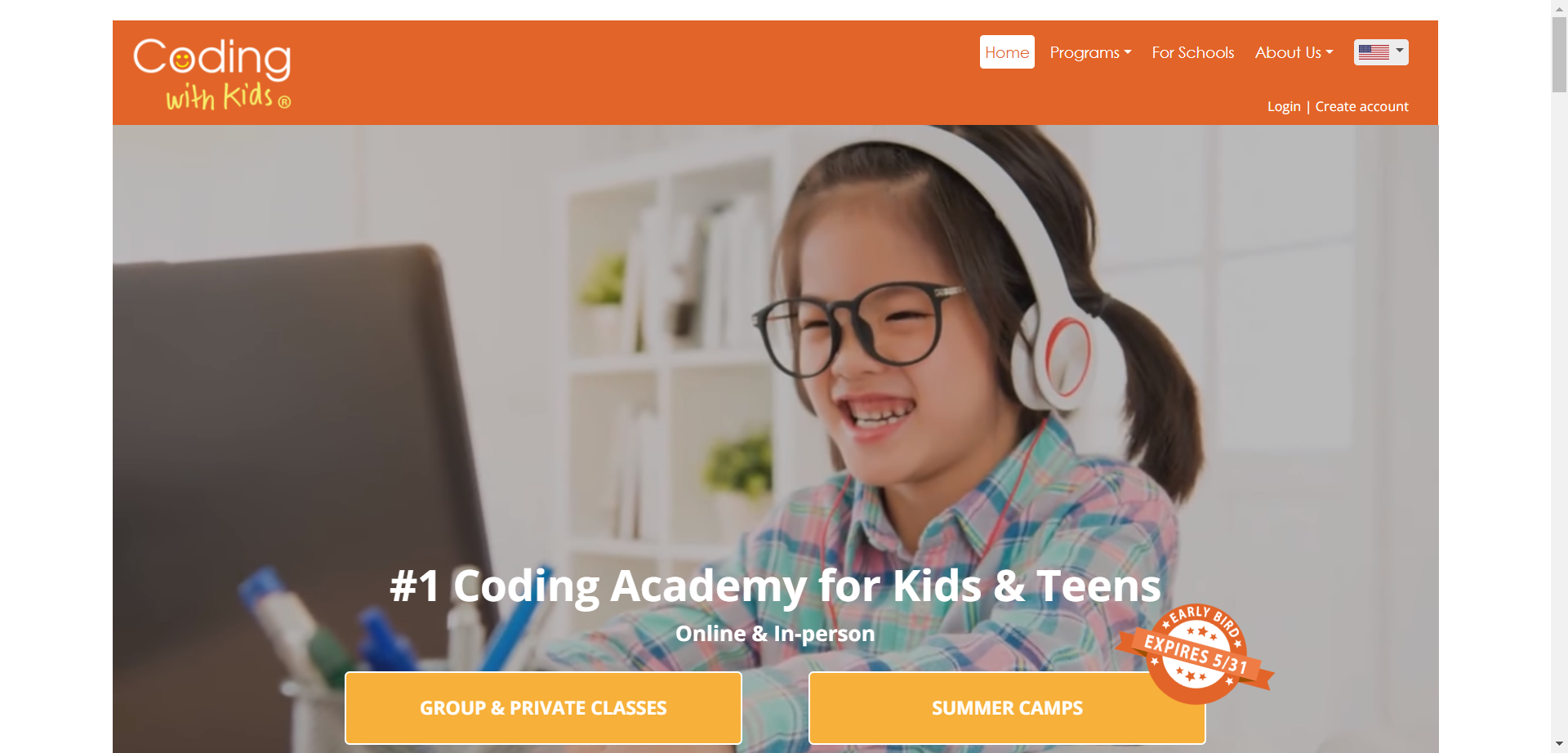
Looking for a way to bond with your child and explore coding together? Coding with Kids offers a unique approach with fun, family-oriented coding classes.
These classes are designed for parents and children to learn the basics of coding side-by-side, fostering teamwork, communication, and a shared love of learning.
Features:
- Family-oriented coding classes for parents and children to learn together
- Focuses on fun and engaging activities that appeal to both adults and kids
- Offers various coding languages and concepts for different skill levels
- In-person and online class options available (depending on location)
- Encourages teamwork, communication, and problem-solving skills
Best Suited For: All ages (families with children interested in coding)
Price: Varies depending on class format, duration, and location
Pros:
- Fun and engaging way for families to bond over a shared learning experience
- Provides valuable parent-child interaction and fosters communication skills
- Caters to different age groups and skill levels within families
- Offers both in-person and online class options for flexibility
Cons:
- Requires a paid enrollment, which might not be feasible for all families
- Availability of in-person classes might be limited depending on location
- Might not be suitable for individual learners who prefer a more independent approach
10. Roblox Studio
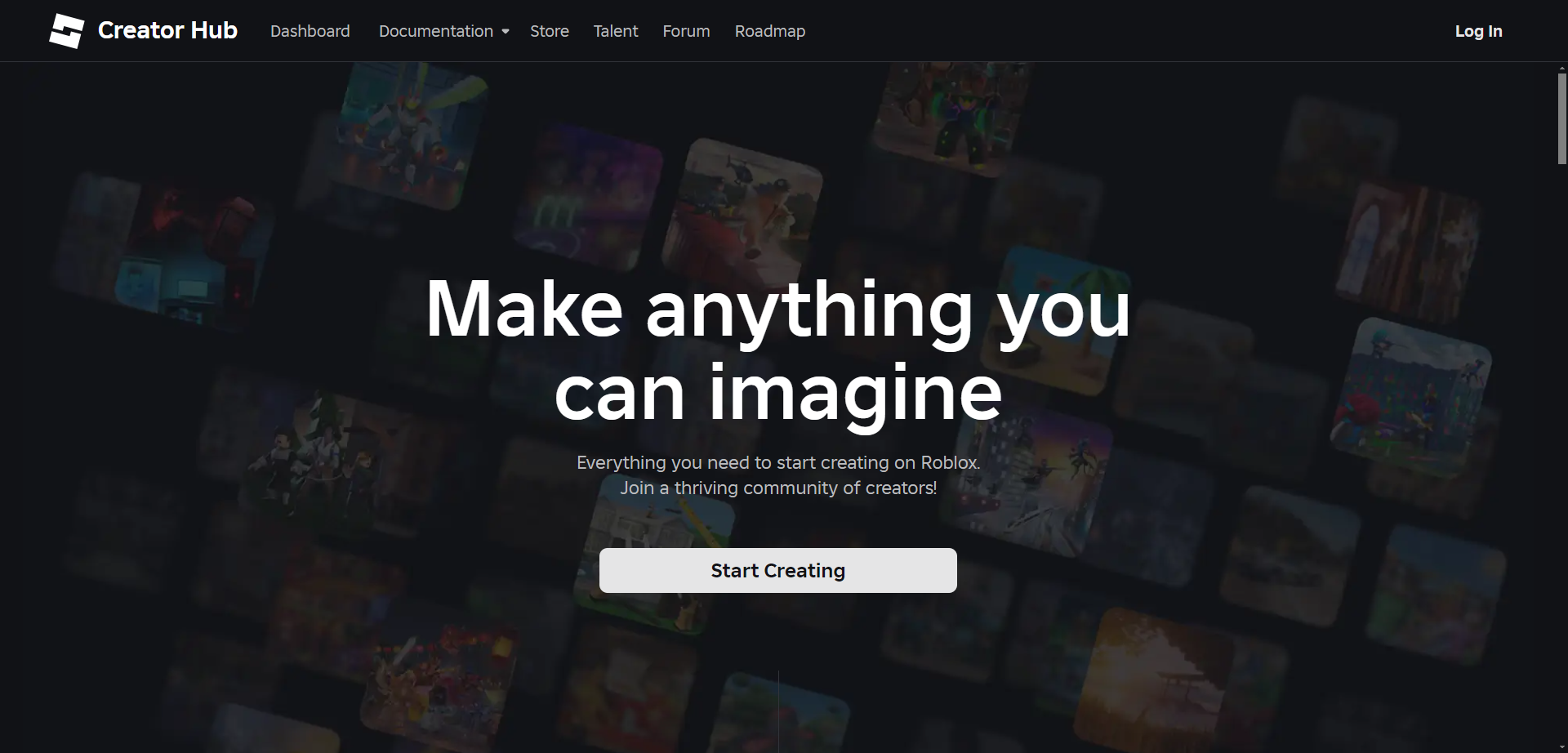
Roblox Studio takes game creation to a whole new level by allowing kids to not only design games but also program them using Lua scripting.
This platform is perfect for budding game developers who want to bring their creative visions to life with code.
While Roblox Studio offers a steeper learning curve, it also opens doors to incredible creative possibilities.
Features:
- Free to use with optional premium features
- User-friendly interface for building game environments and characters
- Introduces scripting with Lua, a popular programming language used in game development
- Large online community for sharing creations and getting inspired
- Offers tutorials, challenges, and resources for learning Lua scripting
Best Suited For: Ages 10-16 (beginners with some experience, interest in game design)
Price: Free to use with optional in-app purchases for premium features and game assets.
Pros:
- Perfect for kids who are passionate about game design and want to learn the coding skills behind it
- Offers a fun and interactive way to learn Lua scripting, a valuable skill in the game development industry
- Encourages creativity, problem-solving, and logical thinking in a game-centric environment
- Large online community provides support, inspiration, and opportunities to showcase creations
Cons:
- Lua scripting has a steeper learning curve compared to block-based coding
- Might be overwhelming for absolute beginners with no prior coding experience
- In-app purchases for premium features can add up
11. Minecraft Education Edition
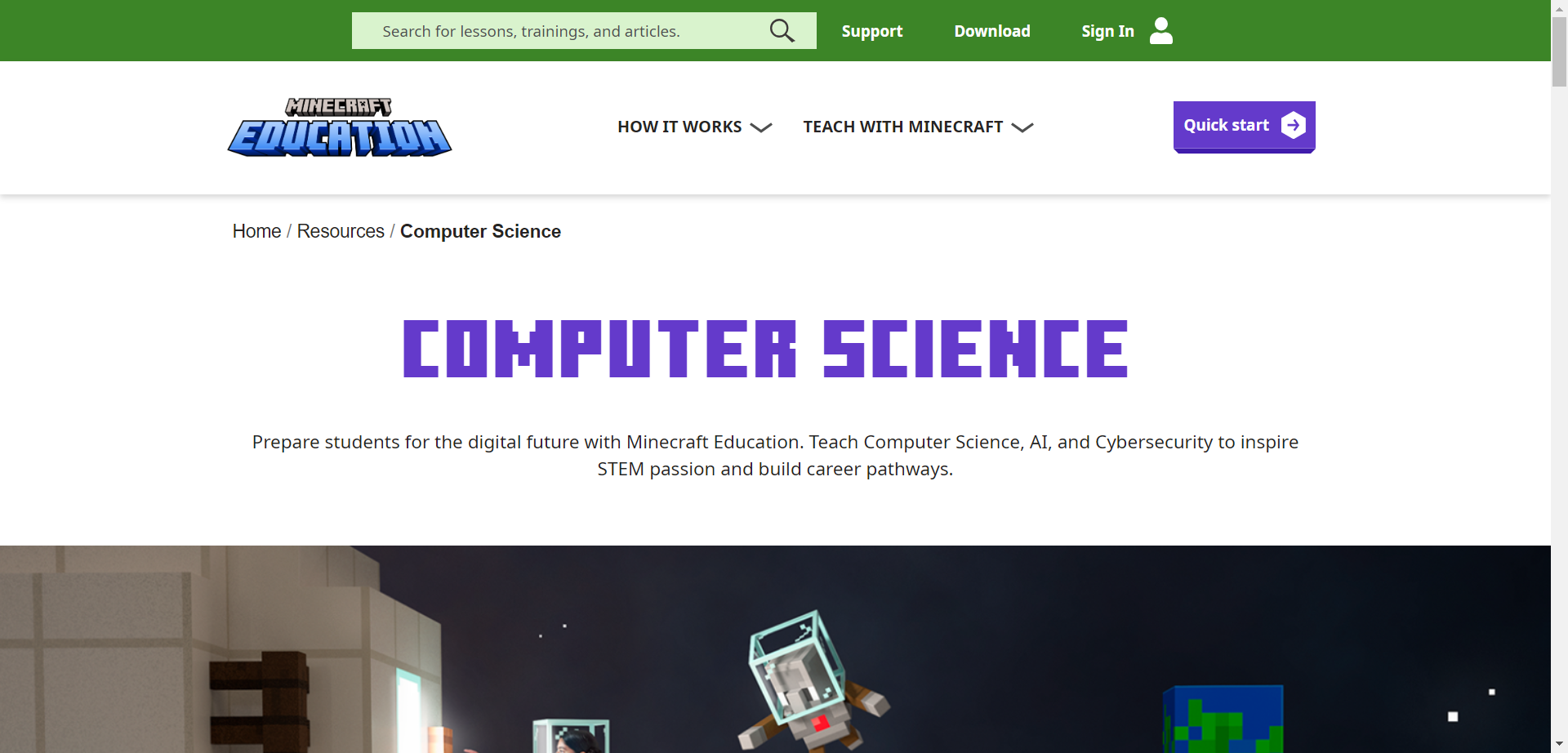
If your child is already a Minecraft enthusiast, then Minecraft Education Edition is a dream come true! This special version of Minecraft integrates seamlessly with coding concepts, allowing kids to bring their creations to life with code.
Students can use block-based coding tools like Blockly or Javascript to build structures, automate tasks, and even create custom game modes.
Features:
- Paid subscription required for schools and individual users
- Familiar Minecraft environment with additional educational features
- Integrates block-based coding (Blockly) and text-based coding (JavaScript)
- Students can create structures, design circuits, and even program mobs
- Offers various lesson plans and challenges aligned with curriculum standards
Best Suited For: Ages 8-14 (beginners with some experience, Minecraft players)
Price: Paid subscription required (varies depending on license type)
Pros:
- Leverages the popularity of Minecraft to make learning to code fun and engaging
- Offers multiple coding pathways (block-based and text-based) for different skill levels
- Encourages creativity and problem-solving in a familiar and beloved game environment
Cons:
- Requires a paid subscription, which might not be feasible for all families
- Might be too complex for absolute beginners with no prior coding experience
- Relies on an existing interest in Minecraft
Some Additional Coding Resources
While the previous mentions were focused on general coding platforms for beginners, here are some additional resources to explore depending on your specific goals;
W3Schools: This comprehensive website offers free tutorials and references for a wide range of web development languages like HTML, CSS, and Javascript. It’s a great resource for self-paced learning and quick reference guides.
AoPS (Art of Problem Solving): While primarily focused on math concepts, AoPS offers some excellent introductory programming courses using Python and Java. These courses can be a good fit for students with a strong math background who want to apply their problem-solving skills to coding.
ChatGPT (and other large language models): While not a traditional course, large language models like ChatGPT can be a useful tool for generating code snippets, translating between programming languages, and answering basic coding questions. However, it’s important to remember that these models are still under development, and their output should always be double-checked for accuracy.
Ourkids: This website connects users with various coding programs for kids. It’s a valuable resource for parents searching for age-appropriate coding classes or summer camps in their area. However, keep in mind that Ourkids itself doesn’t provide the learning content, so you’ll need to explore the linked programs for details.
Also Read: 10 Best Code Editors For Kids
Final Thoughts
As coding skills are becoming increasingly important for many future careers, knowing the Best Coding Courses For Kids in 2024 is a very important step in their journey.
The good news is, with the help of these fun and engaging websites, you can give your child a head start in this exciting world.
Remember, the most important thing is to find a website that matches your child’s interests and learning style.
Don’t be afraid to explore different options as listed above and let them have fun experimenting.


